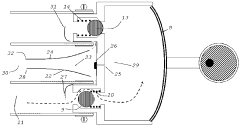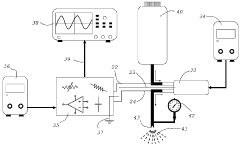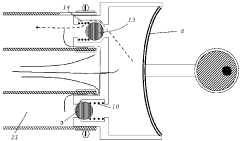Check Valves With Integrated Sensors And Monitoring Systems For Improved Performance And Reliability
NOV 7, 20244 MIN READ
Generate Your Research Report Instantly with AI Agent
Patsnap Eureka helps you evaluate technical feasibility & market potential.
Check Valve Technology Background And Goals
The primary objective is to provide a comprehensive overview of the technological background and evolution of check valves integrated with sensors and monitoring systems. This includes tracing the historical development of this technology, identifying key milestones and breakthroughs, and outlining the expected technological goals and advancements in the near future. The report will shed light on the driving forces behind the integration of sensors and monitoring capabilities into check valves, such as the need for improved performance, reliability, and predictive maintenance capabilities.
Additionally, the report will explore the current state of the art in this field, highlighting the latest technological achievements and the remaining challenges that need to be addressed. It will also discuss the geographical distribution of research and development efforts in this area, providing insights into the regions or countries that are leading the way in this technology.
Additionally, the report will explore the current state of the art in this field, highlighting the latest technological achievements and the remaining challenges that need to be addressed. It will also discuss the geographical distribution of research and development efforts in this area, providing insights into the regions or countries that are leading the way in this technology.
Check Valve Market Demand Analysis
- Market Size and Growth
The global market for check valves with integrated sensors and monitoring systems is expected to experience significant growth in the coming years. This growth is driven by the increasing demand for reliable and efficient fluid control systems across various industries, such as oil and gas, power generation, and water treatment. - Industry Trends
Several trends are shaping the market demand for these advanced check valves:- Emphasis on asset integrity and preventive maintenance
- Adoption of Industry 4.0 and digitalization initiatives
- Stringent regulations for safety and environmental compliance
- Key Applications
The primary applications driving the demand for check valves with integrated sensors and monitoring systems include:- Oil and gas pipelines and processing facilities
- Power generation plants (nuclear, thermal, and renewable)
- Chemical and petrochemical plants
- Water and wastewater treatment facilities
- Regional Market Dynamics
The demand for these advanced check valves varies across different regions:- North America and Europe have well-established markets due to stringent regulations and a focus on asset integrity.
- Asia-Pacific is expected to witness the highest growth rate, driven by rapid industrialization and infrastructure development.
- The Middle East and Africa regions present opportunities due to the expansion of oil and gas projects.
Check Valve Technology Status And Challenges
- Valve Design Evolution
Tracing the development of check valve designs, from traditional swing and lift check valves to advanced designs incorporating sensors and monitoring systems. - Performance Limitations
Identifying key performance issues faced by conventional check valves, such as reverse flow, water hammer, and maintenance challenges. - Monitoring Needs
Highlighting the growing demand for real-time monitoring and diagnostics to improve valve reliability, prevent failures, and optimize maintenance schedules. - Integration Challenges
Discussing the technical challenges involved in integrating sensors and monitoring systems into check valve designs, such as space constraints, harsh operating environments, and data transmission issues.
Check Valve Current Technical Solutions
01 Check Valve Structure and Design
The structure and design of check valves, including valve body material, sealing mechanism, and flow path design, impact their ability to prevent backflow and ensure efficient operation, affecting durability and reliability.- Check Valve Structure and Design: The structure and design of check valves, including valve body material, sealing mechanism, and flow path design, impact their ability to prevent backflow and ensure efficient operation, affecting durability and reliability.
- Applications and Operating Conditions: Check valves are used in various industries with specific operating conditions like fluid type, temperature, pressure, and flow rate, which must be considered for selecting and designing valves to meet performance criteria.
- Testing and Evaluation Methods: Various testing and evaluation methods, such as flow testing, pressure testing, cycle testing, and environmental testing, are employed to assess check valve performance and reliability under different operating conditions and identify potential failure modes.
- Maintenance and Monitoring: Proper maintenance and monitoring practices, including regular inspections, preventive maintenance, and condition monitoring techniques, are essential for maintaining check valve performance and reliability over their service life and detecting potential issues before failure.
- Materials and Coatings: The selection of materials and coatings for check valve construction, considering factors like corrosion resistance, wear resistance, and compatibility with the operating environment, significantly impacts their performance, reliability, and longevity.
02 Applications and Operating Conditions
Check valves are used in various industries with specific operating conditions like pressure, temperature, and fluid characteristics, requiring designs that can withstand these conditions and meet application requirements for reliable performance and extended service life.Expand Specific Solutions03 Materials and Coatings
The selection of materials and coatings for check valve components is crucial for ensuring durability and resistance to corrosion, wear, and other environmental factors, enhancing performance and reliability, particularly in harsh or demanding applications.Expand Specific Solutions04 Maintenance and Monitoring
Regular maintenance and monitoring of check valves, including periodic inspections, testing, and condition monitoring, are essential for ensuring continued performance and reliability, identifying potential issues, and enabling timely maintenance or replacement to reduce the risk of valve failure.Expand Specific Solutions05 Testing and Performance Evaluation
Rigorous testing and performance evaluation methods are employed to assess the reliability and performance of check valves under various operating conditions, simulating real-world scenarios and identifying potential weaknesses or areas for improvement in valve design or materials.Expand Specific Solutions
Check Valve Main Player Analysis
The competitive landscape for research on check valves with integrated sensors and monitoring systems is characterized by a mix of established and emerging players. The industry is growing, driven by the need for enhanced reliability and performance across various applications. Key players like Ford Global Technologies LLC, Watts Regulator Co., and Fisher Controls International LLC leverage their expertise in valve technology.
Watts Regulator Co.
Technical Solution: Watts Regulator Co. offers advanced check valves with integrated sensors and monitoring systems for real-time data collection, analysis, and remote monitoring for predictive maintenance.
Strength: Advanced sensor integration and real-time monitoring. Weakness: High initial cost and complex installation.
Fisher Controls International LLC
Technical Solution: Fisher Controls International LLC offers durable and precise check valves with integrated sensors for industrial applications, providing accurate performance data and early fault detection.
Strength: High durability and precision. Weakness: Limited to industrial applications.
Check Valve Key Technology Interpretation
METHOD FOR INSPECTING THE OPERATION OF CHECK VALVES AND THEIR SUBCOMPONENTS IN REAL TIME AND IN OPERATION
PatentPendingBR102022010808A2
Innovation
- A method of inspecting the operation of check valves and their subcomponents in real-time and during operation using low-cost electrodes inserted in a minimally invasive way.
- The electrical signals from the electrodes are proportional to the instantaneous performance of the valves, allowing real-time monitoring and evaluation.
- The use of a reference electrode enables synchronization of electrical signals in multiple valve systems, facilitating comprehensive monitoring.
Check Valve Sensor Integration Economic Analysis
The integration of sensors and monitoring systems into check valves presents a significant economic opportunity. By enabling real-time monitoring and predictive maintenance, these advanced check valves can reduce downtime, extend equipment lifespan, and optimize operational efficiency. The initial investment may be higher, but the long-term cost savings from reduced maintenance, fewer unplanned shutdowns, and improved reliability can outweigh the upfront expenses. Additionally, the data insights gained from integrated sensors can inform process optimization, further enhancing profitability. Overall, the economic benefits of improved performance and reliability make sensor-integrated check valves a compelling investment for industries reliant on critical fluid systems.
Check Valve Sensor Integration Policy And Regulatory Impact
The integration of sensors and monitoring systems into check valves is subject to various regulations and policies that aim to ensure safety, reliability, and compliance. These regulations cover aspects such as material selection, design specifications, testing requirements, and installation guidelines. Regulatory bodies like ASME, API, and ISO play a crucial role in establishing industry standards and best practices. Additionally, local and regional authorities may have specific requirements for certain applications or industries. A comprehensive understanding of these regulations is essential to ensure the successful implementation and operation of sensor-integrated check valves while meeting all necessary safety and performance criteria.
Unlock deeper insights with Patsnap Eureka Quick Research — get a full tech report to explore trends and direct your research. Try now!
Generate Your Research Report Instantly with AI Agent
Supercharge your innovation with Patsnap Eureka AI Agent Platform!



